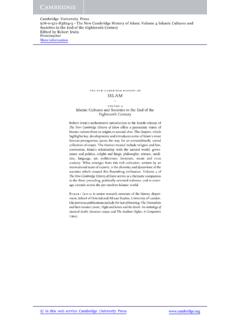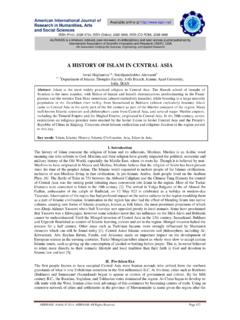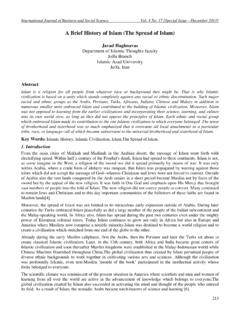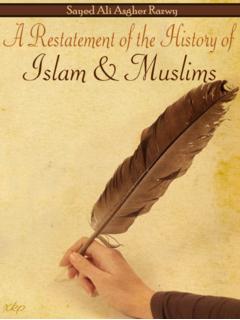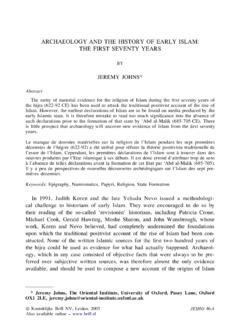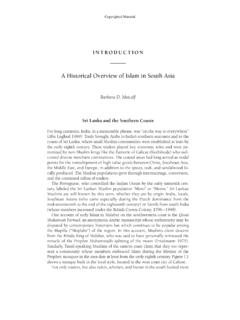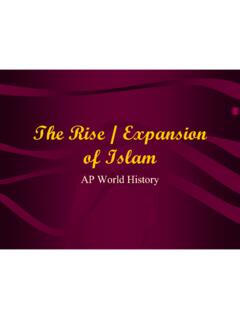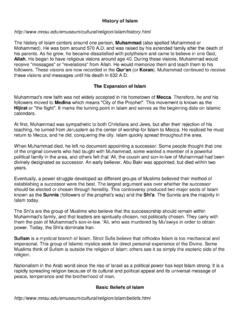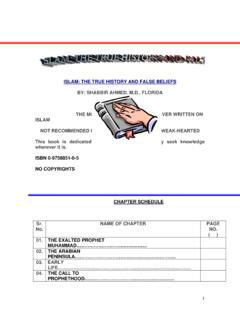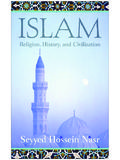Transcription of A History of Muslims in America - Islamic Networks Group …
1 A History of Muslims in America An Interactive Curriculum for Middle and High SchoolsDeveloped by INGING 3031 Tisch Way, Suite 950 San Jose, CA 95128 Phone: curriculum A History of Muslims in Americawas designed to supplement content standards in socialstudies and world History as it relates to the study of American History . The curriculum was developed by INGbased on our long experience delivering this and other presentations through live speakers. If you live in anarea where there is a local Islamic Speakers Bureau (ISB) program, we recommend inviting a live speaker todeliver the presentation since this provides an opportunity to interact face-to-face.
2 If you live in an area wherethere is no speaker s bureau, or you prefer to deliver the presentation yourself, we have provided the contentfor each slide to accompany the digital presentation. The curriculum is composed of eight lesson plans that each focus on the different parts of the digitalpresentation, A History of Muslims in America . The curriculum begins with notes for each slide in thepresentation. In addition to the presentation notes, each lesson includes discussion questions, activities, andfilm clips that you can link to as well as discussion questions about the films.
3 While the presentation can beused independently, it is more effective when supplemented by film clips which highlight the different topicsaddressed in each lesson. Please use the clips that you feel will resonate best with your students. These lessonswere designed to be used either jointly or independently as stand-alone curriculum depending on the timeavailable and your desired focus. For educators who want a more general overview, we also provide a basiccurriculum about muslim beliefs and practices called Getting to Know American Muslims and Their Islamic Networks Group (ING) our mission is to promote interreligious understanding, tolerance, andharmony through dialogue and religious literacy.
4 It is our hope that through this curriculum we can providebalanced information to educators that will help supplement their curriculum in a manner that is relevant,engaging and Standards _____This eight part series of lessons and accompanying activities for A History of Muslims in Americaare designed tosupport teachers in middle and high schools. This curriculum addresses many themes created by the NationalCouncil for the Social Studies Curriculum Standards and the National Center for History in the Schools atUCLA. Many of these themes are also addressed in state social studies content standards including the statesof California, Texas, and New ThemesConcepts such as beliefs, values, mores, institutions, cohesion, diversity, accommodation, adaptation,assimilation, and dissonance (National Curriculum Standards for Social Studies 1: Culture)Different interpretations of key historical periods and patterns of change within and across nations, cultures,and time periods (National Curriculum Standards for Social Studies 2.)
5 Time, Continuity, and Change)That complex and varied interactions among individuals, groups, cultures and nations contribute to thedynamic nature of personal identity (National Curriculum Standards for Social Studies 4: IndividualDevelopment and Identity) Concepts such as: mores, norms, ritual, status, role, socialization, ethnocentrism, cultural diffusion,competition, cooperation, conflict, assimilation, race, ethnicity, and gender (National Curriculum Standards forSocial Studies 5: Individuals, Groups, and Institutions) Concepts and ideals such as: human dignity, social justice, liberty, equality, inalienable rights, responsibilities,civil dissent, citizenship, majority and minority rights, the common good, and the rule of law (NationalCurriculum Standards for Social Studies 10: Civic Ideals and Practices) P A G E i COPYRIGHT 2011 ING.
6 ALL RIGHTS RESERVED I N T R O D U C T I O N A History OF Muslims IN America Analyze the role religion played in the founding of America , its lasting moral, social, and political impacts andissues regarding religious liberty (National Center for History in the Schools US History Content Standards Era 2: Standard 2; Social Science Content Standards for California Public Schools ; New York ContentStandards Social Studies 7-8: United States and New York State History Unit Texas EducationAgency Curriculum Standards-Social Studies US Government )Contributions of religious groups to American social change (National Center for History in the Schools USHistory Content Standards Era 4: Standard 4; Social Science Content Standards for California Public Schools )Religious pluralism from 20th century immigration (Social Science Content Standards for California PublicSchools.)
7 New York Content Standards Social Studies 7-8: United States and New York State History Unit ; Texas Education Agency Curriculum Standards-Social Studies US History )Trace the origins and development of American slavery (National Center for History in the Schools USHistory Content Standards Era 2: Standard 3; Social Science Content Standards for California Public Schools ; New York Content Standards Social Studies 7-8: United States and New York State History )Examples of the lives of freed slaves (Social Science Content Standards for California Public Schools )Examples of leaders of abolition movement (Science Content Standards for California Public Schools )Identify the new sources of large-scale immigration and the contributions of immigrants to the building ofcities and the economy (National Center for History in the Schools US History Content Standards Social -Era 6: Standard 2.
8 Social Science Content Standards for California Public Schools ; New York ContentStandards Social Studies 7-8: United States and New York State History Unit )Location and impacts of renewed immigration (Social Science Content Standards for California Public Schools immigration movements (Social Science Content Standards for California Public Schools the major social problems and domestic policy issues in contemporary American society (NationalCenter for History in the Schools US History Content Standards Era 10: Standards 1 & 2)Lesson Topics_____This curriculum A History of Muslims in Americais divided into eight distinct lesson plans with accompanyingpresentation notes, discussion and test questions, activities, and supplemental films.)
9 Each lesson covers thetopics outlined below, which can be used alone or as part of the entire One: Muslims and America : A Long History American Muslims : A Diverse Community Morocco and American Independence The Founding Fathers and Religious Freedom A Brief Timeline of American muslim HistoryCOPYRIGHT 2011 ING. ALL RIGHTS RESERVED P A G E i iA History OF Muslims IN America I N T R O D U C T I O NLesson Two: Before Columbus Did Muslims Come Before Columbus?
10 Could African Muslims Have Crossed the Ocean? Crossing the Western Ocean: A West African Tale Traces of African Muslims in Clay Figures from Ancient America (early 1300s)Lesson Three: Enslaved West African Muslims Esteban: The First African American Second Old World Faith in the New World Job, the Son of Solomon Yarrow Mamout Prince: Abdul Rahman ibn Ibrahim Sori Omar ibn Said Two Georgian Bilalis: Bilali Muhammad and Salih Bilali Descendants of muslim SlavesLesson Four: African American Rediscovery of muslim Roots The Islamic Mission of America The Moorish Science Temple The Moorish Science Newspaper The Nation of Islam The Legacy of Malcolm X The Nation of Islam under Imam W.
